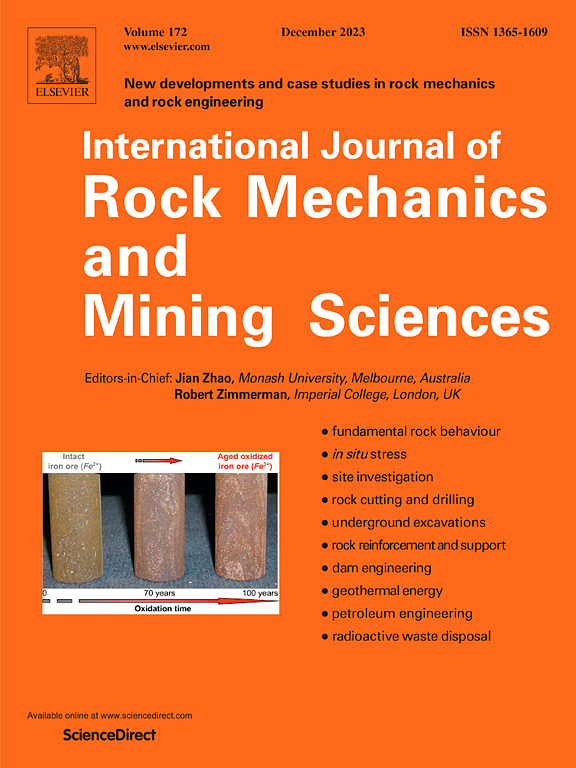A realistic 3D grain-based modeling approach for reproducing the mechanical and failure behavior of brittle granites
IF 7
1区 工程技术
Q1 ENGINEERING, GEOLOGICAL
International Journal of Rock Mechanics and Mining Sciences
Pub Date : 2024-11-30
DOI:10.1016/j.ijrmms.2024.105981
引用次数: 0
Abstract
Exploring cracking behavior from mineral-scale do good help to understand the failure mechanism of rock materials. The present study proposes a realistic three-dimensional grain-based modeling (3D-GBM) method considering the actual distribution, geometry and mesoscopic mechanical properties of different minerals in granite samples. The geometrical characteristic and distribution were captured based on high-precision computed tomography (CT) scanning and polarized microscopy. The mesoscopic mechanical properties were measured using nanoindentation combined with the scanning electron microscope-energy dispersive spectroscopy scanning (SEM-EDS). The results indicate that the established model can realistically reproduce the mechanical and failure behavior of granite subjected to unconfined compression in terms of stress-strain curves, failure mode, crack evolution, and force transmission. Investigating crack propagation at mineral-scale shows that the relative damage degree is greater at weak boundaries (i.e., boundary related to mica) and relatively soft minerals (i.e., mica) than that of strong boundaries (i.e., quartz-quartz and quartz-feldspar) and stiffer minerals (i.e., quartz and feldspar). Grain boundaries and soft mica minerals play an important role in guiding and deflecting the crack propagation path due to the mismatch in elasticity and strength compared with the stiffer and harder minerals (i.e., quartz and feldspar).
一种真实的基于颗粒的三维建模方法,用于再现脆性花岗岩的力学和破坏行为
从矿物尺度上探索岩石的开裂行为有助于理解岩石材料的破坏机制。本研究提出了一种考虑花岗岩样品中不同矿物的实际分布、几何形状和细观力学特性的逼真三维颗粒建模(3D-GBM)方法。利用高精度CT扫描和偏光显微镜技术捕获了其几何特征和分布。采用纳米压痕结合扫描电子显微镜-能谱扫描(SEM-EDS)技术测量了材料的细观力学性能。结果表明,所建立的模型在应力-应变曲线、破坏模式、裂纹演化和力传递等方面能较好地再现无侧限压缩作用下花岗岩的力学和破坏行为。在矿物尺度上研究裂纹扩展表明,弱边界(即与云母有关的边界)和相对较软的矿物(即云母)的相对损伤程度大于强边界(即石英-石英和石英-长石)和较硬的矿物(即石英和长石)。与较硬、较硬的矿物(如石英和长石)相比,晶界和柔软的云母矿物由于弹性和强度的不匹配,对裂纹扩展路径起着重要的引导和偏转作用。
本文章由计算机程序翻译,如有差异,请以英文原文为准。
求助全文
约1分钟内获得全文
求助全文
来源期刊
CiteScore
14.00
自引率
5.60%
发文量
196
审稿时长
18 weeks
期刊介绍:
The International Journal of Rock Mechanics and Mining Sciences focuses on original research, new developments, site measurements, and case studies within the fields of rock mechanics and rock engineering. Serving as an international platform, it showcases high-quality papers addressing rock mechanics and the application of its principles and techniques in mining and civil engineering projects situated on or within rock masses. These projects encompass a wide range, including slopes, open-pit mines, quarries, shafts, tunnels, caverns, underground mines, metro systems, dams, hydro-electric stations, geothermal energy, petroleum engineering, and radioactive waste disposal. The journal welcomes submissions on various topics, with particular interest in theoretical advancements, analytical and numerical methods, rock testing, site investigation, and case studies.

 求助内容:
求助内容: 应助结果提醒方式:
应助结果提醒方式:


